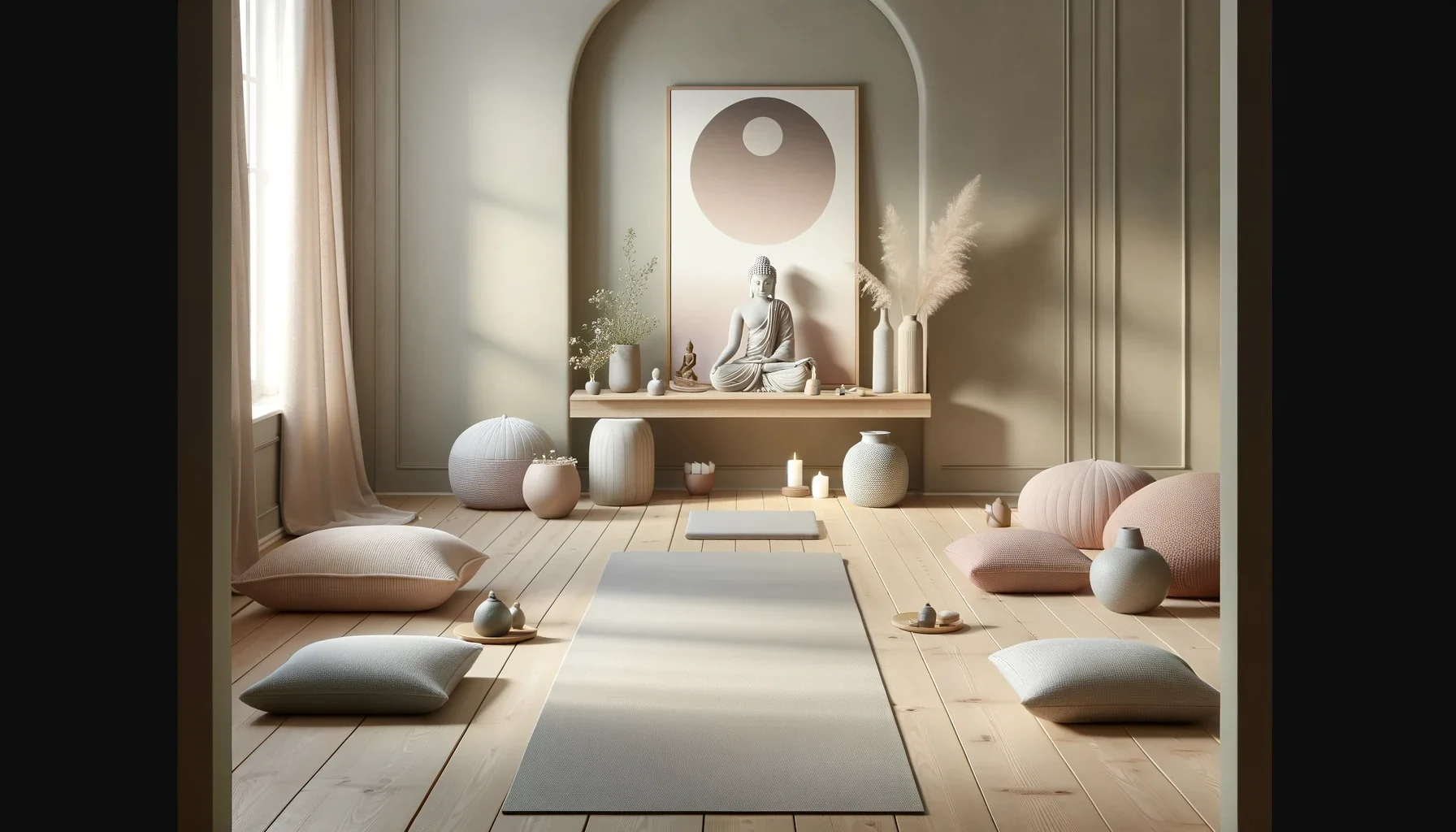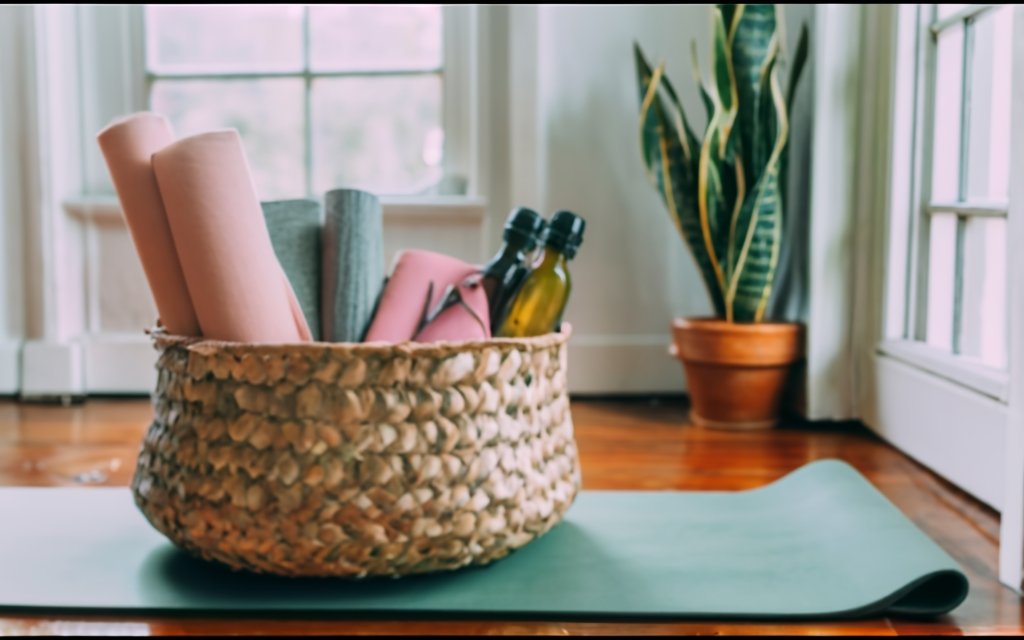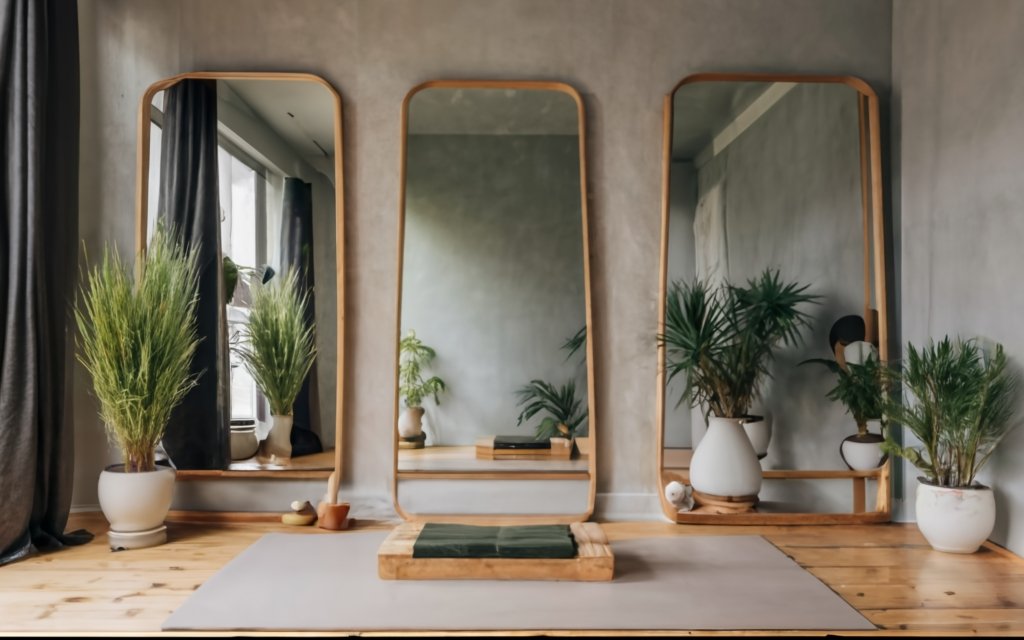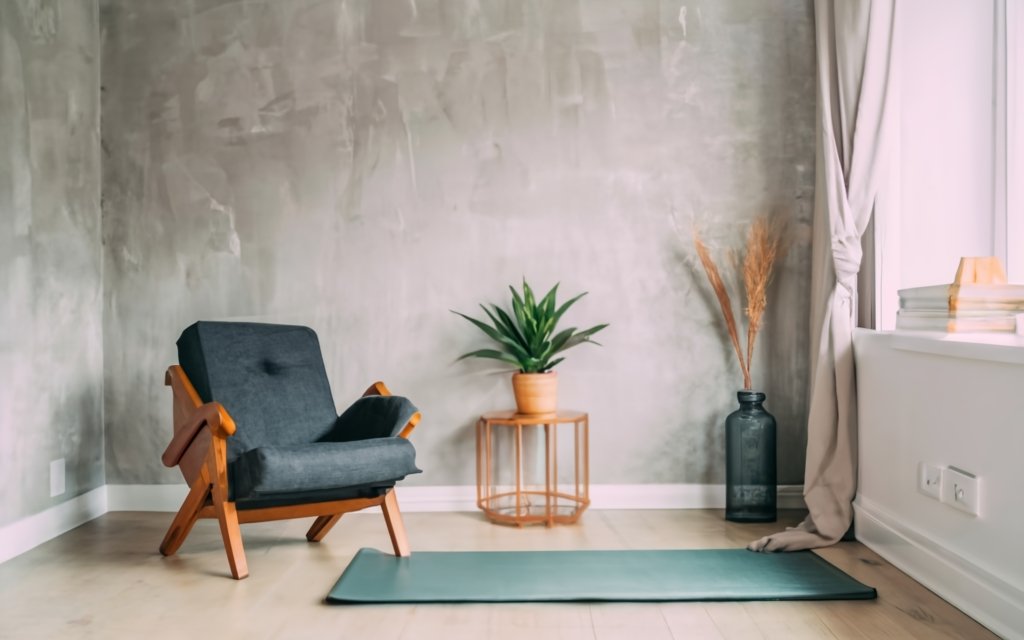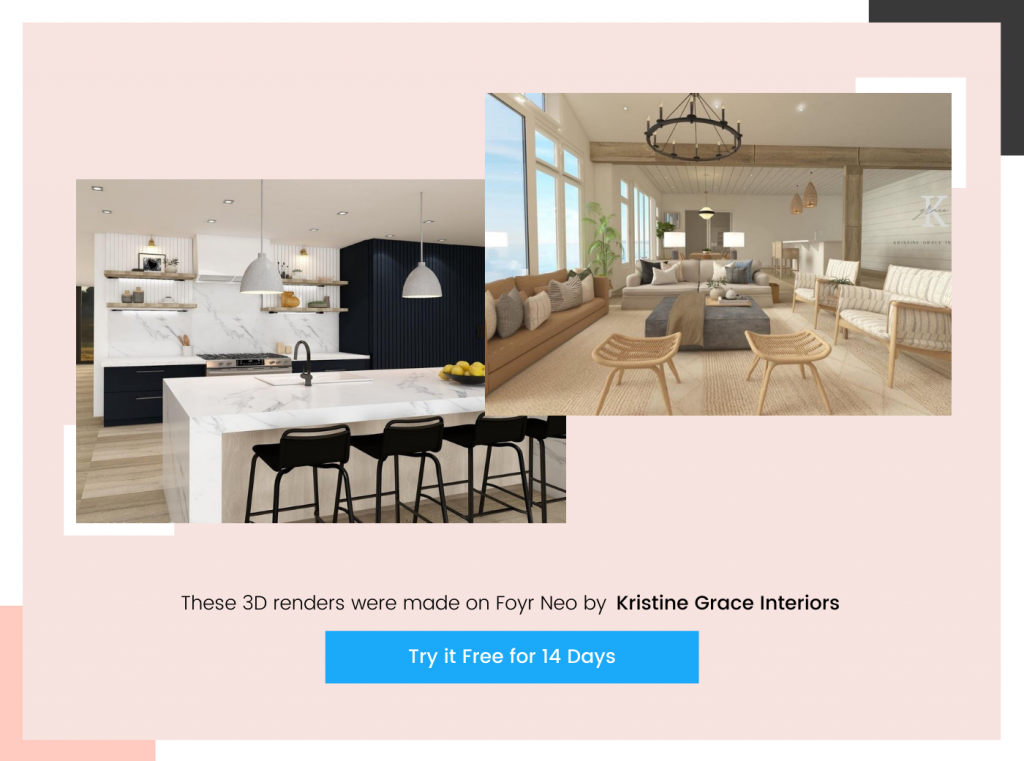Table of Contents
Learn » Design Ideas & Inspirations »
Who doesn’t love meditating in a serene environment with absolute peace surrounding you? With your worries disappearing, you lose the heaviness in your heart and find a new calmness in your mind and body. Now imagine having that blissful feeling every day, without the hassle of commute, paying for weekly lessons, fighting to make time in your routine, and eventually giving up on your meditate-everyday-for-30-minutes-goal.
You have dedicated meditation and home yoga space for your daily practice. It’s not just any space. With proper mood-boosting features, design elements, and makeover items, it’s the best gift and investment you can make for yourself and your family.
Let’s delve deep to figure out how you can design a soulful meditation space at home this year and transcend into a different realm while still being at home.
Benefits Of Having A Meditation Space At Home
- You can stick to your meditation routine without any disturbance.
- Creating a sanctuary in your own home is sacred.
- Your mind settles down soon and stays focused for a long time.
- When you meditate in a space regularly, you will exude a calm energy and aura in that place, which yields a lot of health benefits.
- By stepping into your own meditation space, you will find yourself breathing deeper and relaxing through mere association.
Read also – How To Become a Certified Interior Designer Without A Degree in 2024?
Where to look for inspiration before you begin?
In the conceptualization phase where you’re browsing through ideas on Pinterest and other social media, you might want to look at meditative spaces around the world. While you’re at it, don’t forget some of the colossal spaces that have a huge calming impact on millions of people around the world – places of worship of different cultures. Yes, they are some of the places with brilliant architecture, and their interior design elements have phenomenal calming properties. You could borrow some ideas from them. Let’s go over a few attributes.
Churches
The Basilicas are inspired by the Roman architectural style, and they have plenty of arches, clerestory windows, stone and mortar, mosaic interiors, lots of open spaces, and courtyards. Materials like stone, patterns like arches, and open spaces blur the line between interior and exterior and make the space feel close to our hearts, thus opening our minds to soulful prayer and focused meditation.
Temples
Temples in India and other countries are ornately designed, with skillfully painted, or sculpted walls, steeply sloped roofs, candles, torches, and incense burning. You can see fire, air, Earth, and water elements being used wisely to appeal to all your senses. The axial and symmetrical nature, with emphasis on the important interior elements, while exuding a calming ambiance is their specialty.
Mosques
With forest-like arcades, columns arranged in a square plan, and lots of intricate patterns and soft lines in the walls, ceiling, and floor, they are built on a central and axial plan. They have carpets all along the building which helps in maintaining acoustics and keeping a rather quiet environment.
Read also – How to Design and Decorate a Dining Room?
Yoga room and Meditation room ideas
The last thing you want to happen when you’re zooming into your zone is to be disturbed by loud honking, notifications from your phone, or your neighbor’s incessantly barking dog. On the flip side, you also don’t want the relaxing space to be so silent that you drift off and lose track of your meditation time. You mustn’t be overstimulated or understimulated. Here’s how you find the sweet spot.
Prioritize privacy
| Olivia Bowser, the CEO and founder of Liberate, a mental wellness studio and interior design consultant in LA says, “ Stay away from disruptive noises, kids, devices, and intrusive noises, and make sure your sacred space is distant from any intrusive disturbances.” |
The ideal location for your meditation space needs to be secluded so you aren’t disturbed and yet should be easily accessible, so you can take short meditation breaks anytime you want. You can design a meditation space and home yoga room wherever you want, be it a den, part of the living room, a family room, an extra bedroom, etc. Any escape room that has ample space for you would do.
Clear any clutter
In a place you have devoted to your wellbeing, you want everything to be in its place, so your mind can freely think, converge its thoughts, and give you the peacefulness you’re after. Make sure you don’t leave room for anything to lie around in the space. Clutter isn’t reflective of the energy you’re trying to cultivate and it’s best to steer clear of it.
Aim for comfort, but not too much
Too much comfy furniture, warm colors, and a cozy environment can be counterproductive when it comes to designing meditation spaces at home and can put you to sleep. You need a moderately comfortable space that keeps you relaxed yet attentive. You require elements that appeal to different senses, so you’re kept active throughout your meditation session.
Keep the room decor minimal
You don’t need high-end materials to make your meditation room look heavenly. Find something that bolsters meditation, feels your own, a small space that’s away from distractions, and makes you look forward to meditating every single day.
Reminisce past place experiences
We associate comfort and tranquility with places we deeply resonate with. If you ever felt at home when being far away from home, felt nourished, fresh, and full of life in a particular setting, try to recollect what about the place gave you peace and joy. Try to recreate the same experience in your home meditation space.
Read also – Best Kitchen Lighting Ideas
Decor ideas to create a Zen meditation space
In her thesis, Fatemeh Monzavi lists down the factors that make a space conducive to meditation and well-being – proportion, scale, variety, ornamentation, color and texture, smell, sound, temperature, and visual quality. The design ideas we’re going to delve into cover all these elements in detail.
1. Noise-canceling headphones or soundproofing
Canceling any disturbing noise is important. If you do guided meditation, or listen to calming music, it’s best to put on noise-canceling headphones or soundproof your meditation space with heavy draperies and curtains.
2. Clutter-free space and storage
Keep your Yoga mat, towels, earplugs, or water bottles placed in a natural basket and tucked away in a storage compartment. Keep the floor clean and declutter it often. It has a profound impact on your mind.
3. Easily cleanable, tactile flooring
You may have water bottles or herbal tea with you when you meditate and perform Yoga in your Yoga room. Or, you have essential oils with you when you meditate. There’s a good chance you might topple the container without knowing. You don’t want the flooring to be spoilt. Ensure the flooring is covered with a rug or is made of easily cleanable material that doesn’t stain. Hardwood flooring with rugs is excellent.
Read also – 14 Home Gym Design Ideas to Build the Perfect Gym in 2024
4. Candles and incense
Bright, sweet-smelling candles and incense that brighten up the place and give you a breath of fresh air are the best bets to set a restful atmosphere in the meditation space using aromatherapy. Good smells activate happier memories in your head. These are valuable parts in preparing your mind for meditation.
5. Cozy blankets and fluffy pillows
Invest in soft furnishings overall, like large cushions, wool, mats, and blankets. They melt away any stress you may be carrying and make you easeful. You can also place floor cushions to support your back during meditation.
6. White noise machine
Research says white noise helps you calm down your nerves and unifies your thoughts to concentrate better. That’s why it’s a great idea to have a white noise machine to assist you in meditation.
7. Herbal tea to heighten taste
To recharge before or after your personal best Yoga practice with a warm herbal drink that matches your energy, keep a flask of hot water and herbal tea bags in the space.
Read also – Why Do Professional Interior Designers Need Home Decor Design Software?
8. Simple, low-maintenance houseplants
Get fig plants and such low-maintenance plants in your meditation space, to add visual variety and instill hope and freshness in you. They also improve the air quality in the room. Viewing natural elements like plants decreases discomfort and has a rehabilitative impact on your body. Research says it decreases your blood pressure, and heart rate and positively affects your behavior.
9. Stone pathways and winding streams for exterior spaces
To make your exterior meditation space look dreamy, you can set up stone pathways and create spaces for winding streams so you listen to the calming sound of water trickling as you slowly descend into a peaceful meditation.
10. Artwork on the wall behind furnishings
Studies say that artwork depicting nature, and natural elements when kept in a meditation space enriches the mind-space of the meditator, lifts spirits, and refreshes the body. Get rejuvenating original artwork with a natural scenery that calms you down, and makes you think straight.
Read also – Comparing Laminate Flooring Types, Pros, Cons, and Installation Tips
11. Wall mirrors to add visual depth
Mirrors reflect light, make the space look bigger, and are a symbol of growth, positivity, and happiness. Seeing yourself engrossed in soulful meditation or Yoga can boost your self-image. It can also add to the lighting of the place.
12. Bookshelf for spiritual magazines
If you want a Zen space that holds all items in your spiritual journey in one place, you might want to get a small bookshelf, or create a DIY bookshelf to store your spiritual magazines, which can come in handy when you’re done meditating, but still want to linger in the peaceful zone.
13. Buffet type stands for essential oils
Fragrance is important to engage your olfactory senses and put your mind at ease. Stack your favorite essential oils like lavender, jasmine, lemon, bergamot, Ylang, and clary sage in a rolling buffet-type stand so you can pull the stand closer whenever you settle down for and get on with the meditation practice right away.
14. Side table with flowers
Sweet-smelling flowers add charm to any space. Especially where you want to relax, let your mind think of beautiful, positive things about life, and embrace hope, adding flowers to the side table helps amp up the ambiance a notch. If the fragrance doesn’t agree with you, you can choose faux flowers too.
Read also – 2024 Color of the Year Predictions: An Interior Designer’s Guide
15. Skylights and artificial lighting
Ample lighting makes you happy and helps you think straight. Poor lighting on the other hand can make you anxious, as you won’t be able to engage with the space you’re in. Too much lighting can overstimulate you. Natural lighting, however, makes you feel calm.
| Joy Nan Rodia, an award-winning interior designer, and founder of Ofcourse Interior Design says, “Natural lighting is extremely important to create a soothing atmosphere. Make sure you get most of the sunlight by having sheer curtains on the windows.” |
To maximize natural light, you can install skylights on the roof of your meditation space. Avoid glare and overheating by having screens, shading, or control systems in place. When it comes to artificial lighting, you can do with recess lighting and a couple of lamps to add to the peaceful environment.
16. Add some built-in storage
You can have a multi-purpose sofa, with a built-in compartment or simply whisk away the essentials in a natural basket under any seating arrangement you have in place.
17. Cozy chairs
If you want to make it a reading room as well as a meditation space, a place where you can come to escape from the world, you should get a cozy chair or lounge.
Read also – How Much Does It Cost To Paint The Interior Of A House?
18. Calming wall colors
When doing Yoga, or relaxing exercises, you tend to see the ceiling quite a bit. Don’t forget to add texture and color to the ceilings as well. Blue-green ceilings are preferable for some. Some people like dark, off-forest-green walls and plain ceilings.
| Colors | Impact they create |
| Blue and violet | Decrease blood pressure and body temperature |
| Red and orange | Improve physiological effects |
| Green-yellow, Blue-green Green |
Most exciting colors |
| Violet-blue, Yellow-red |
Less exciting, colors |
| Cool green | Exudes frustration and uncertainty |
19. Introduce natural materials wherever possible
Add natural materials like marble, wood, and stone, wherever possible when designing meditation spaces at home. Avoid straight lines to steer clear of an industrial look, and double down on arches, and curved spaces for the best impact. When you bring in nature-like materials, your mind thinks you’re close to nature, and helps you relax easily.
20. Form groups of three
Bring different textures, heights, and sizes together in groups of three, and create palpable negative space. This helps you to focus more and better. It also stimulates your brain to the right levels.
21. Match ceiling heights to ambiance
If you want to feel like being in a spacious room, go for high ceilings. If you want to experience comfort and coziness when meditating, go for low ceilings. You’ll be amazed at the difference they can make.
How can you truly personalize your meditation space?
Instead of blindly ordering every Zen-like home decor material and over-cluttering your space, why don’t you start with the mood board? Here’s how you can get started, right away, without paying a penny.
Step 1: Sign up for Foyr’s 14-day free trial.
Step 2: Head to the mood board and bring together your inspiration, aspirational pictures, and saves from Pinterest.
Step 3: Move to the floor plan, create or import the floor plan of your meditation space.
Step 4: Drag and drop all the materials you want there, and view them in 3D.
Step 5: Make corrections, adjust lighting, view the space in different natural and artificial light settings, and finalize the design.
Step 6: Take a preview and get the render done in a few minutes.
Step 7: Create a walkthrough video in 4K quality to experience how exactly your meditation space looks like.
Feel something’s missing in your design? Quickly replace what you dislike and regenerate the design in a few minutes. With Foyr Neo, it’s that simple. Well, what are you waiting for? Sign up for Foyr Neo’s 14-day free trial now.
FAQs
Suggest recycled or upcycled furniture, use non-toxic and sustainable materials, and promote energy-efficient lighting options.
Ensure a seamless transition with consistent design elements, calming color schemes, and the use of natural materials that connect the meditation space with the overall home design.
Define the meditation area with screens or dividers, choose furniture with dual functions, and maintain a cohesive design to ensure a harmonious blend with the overall space.
Conceal technology with hidden outlets, incorporate soundproofing elements, and suggest minimalist devices for guided meditation or ambient music.
Recommend built-in or foldable storage solutions that keep yoga mats, blocks, and other accessories accessible yet neatly organized.









